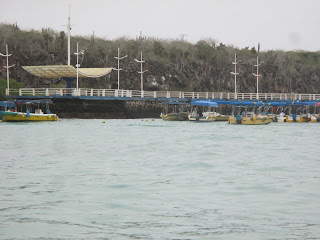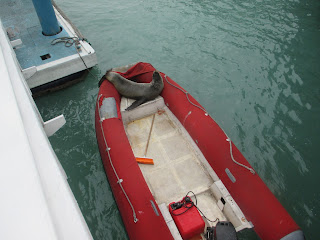Galapagos, Black Turtle Island and Dragon Hill
We were going to another island and a different ecosystem. We went in the Zodiacs and picked our way through some mangrove swamps on Black Turtle Bay (also called Caleta Tortuga Negra) on Isla Santa Cruz.
It was a haven of fauna and a favourite fishing ground. A pelican fishing with a noddy perched on his head. This was a common sight of a noddy perched on a pelican. The pelican dives into the water and scoops up fish and a lot of water in its pouch. It then squeezes the water out and then swallows whatever fish it has caught. Whilst the pelican is draining off the water, sometimes the fish also escape, and this is the opportunity for the noddy to get a quick easy meal as it can grab the fish as it escapes from the pelicans beak.
The mangrove swamps came down to the beach...
and enveloped some of the rocks on the beach...
but they do get flooded. The tidal range on the islands isn't very great until there is a storm. You can see how high the tide can be as there is a distinct line between the black trunks that get flooded and the grey upper branches.
A heron taking a break from fishing...
and another fisherman...
and a blue footed bobby.
Around us the water was teeming with fish including two metre long sharks. Plus just below the surface was an eagle ray.
And a great sight was a line of golden rays that swept underneath us. When the got to the edge of the mangrove they turned clockwise as if they were responding to a military command and swept back beneath the boats and back the way they had come.
More blue footed bobbies standing on a rock with some flooded mangrove swamp that was standing in the water. The mangove plant stand in salt water and inevitably pick up salt. They get rid of surplus salt by pushing it into certain leaves that turn yellow and drop off into the water.
After Black Turtle Bay we moved along the coast to Cerro Dragon or Dragon Hill for a walk and another snorkel.
Here were black marine iguanas whose main food is algae that grows on the rocks underwater. They are good swimmers but need to warm up before they go swimming.
They get a lot of salt in their diet and have evolved a special way of getting rid of it. They had glands in their nostrils and they 'sneeze' out surplus salt...so it is best not to stand in front of them.
This is a dry island and much of the vegetation is cactus or drought resistant plants.
But the plants also give a lot of shade and hiding places and inland were a number of iguanas.
These two males were having a fight circling each other with occasional grappling and biting.
a close up of one of the iguanas...
and this is what they were fighting over, a female.
And then it was back to the beach for another snorkel and a whole host of fish such as hieroglyphic hawkfish, panamic fanged blenny, burrito grunt, king angelfish,
Cortez rainbow wrasse just to name a few but regretably I had no waterproof camera. Then we moved on to circumnavigate the island to reach Puerto Ayorta which is the capital of the Galapagos.



















































